Украшения и орнаментированные бивни из верхнепалеолитического поселения Юдиново
Ornaments and Ornamented Tusks from the Upper Palaeolithic Site at Yudinovo
Author(s): Galina V. GrigoryevaSubject(s): History, Archaeology, Cultural history, Visual Arts
Published by: Издательский дом Stratum, Университет «Высшая антропологическая школа»
Keywords: Ornaments; Ornamented Tusks; Upper Palaeolithic Site; Yudinovo;
Summary/Abstract: A rich assemblage of bone and tusk items from Yudinovo site (Bryansk oblast, Russia) finds its analogues among the Upper Palaeolithic sites in the basin of Desna river. A set of ornaments (bead necklaces, pendants, “fibulae”, bracelets, diadems) is often geometrically ornamented. The same ornament, which is predominantly rhombuses, has been noted on fragments of tusk. Radiocarbon dating of these finds, received in the Russian and foreign laboratories, shows 15-14 thousand years ago. Z.A. Abramova and G.V. Grigorieva continue studying this unique site nowadays. Yu.E. Demidenko. «The Crimean Enigma» — Middle Palaeolithic Artifacts within Early Aurignacian of Krems-Dufour Type Complexes at Siuren-I: Alternative Hypothesis for Solution of the Problem. On the results of new 1990s excavations and taking into consideration all published and partially unpublished data on the previous 1879 — 1880 and 1920s excavations at Siuren-I rock-shelter (Crimea) an attempt was undertaken to elucidate the meaning of the Middle Palaeolithic industrial component (techno-typologically very much similar to flints of the Crimean Micoquian Tradition industries) within the site’s Lower layer 1920s / Units «G» and «H» 1990s cultural bearing deposits containing complexes of the European Early Aurignacian of Krems-Dufour type industry. The analysis with the use of the «alternative hypotheses» method led us to the following conceusions. There are no archaeological levels with only Middle Palaeolithic artifacts within the site’s Upper Paleolithic sequence of 4 hearth / ashy lenses of the Lower layer 1920s / Units «G» and «H» 1990s. Various natural disturbance processes (e. g., cryoturbation or water streams erosion) and other ways penetration of Middle Palaeolithic pieces into Upper Palaeolithic levels should not be considered as actual reasons. The «evolutionary idea» on development of Siuren-I Upper Palaeolithic industry with some «Middle Palaeolithic survival elements» from the local Middle Palaeolithic does not correspond to all archaeological, anthropological, and chronological data, either. Ideas on possible contacts and interactions between Aurignacian Homo Sapiens and Micoquian Neanderthals do no seem to be the likely ones at all, otherwise we would have to agree with «a reverse acculturation model» where Neanderthals have introduced a number of their typical industrial elements into Homo Sapiens’ flint treatment and using systems and the latter «modern» human groups fully accepted and used them with no changes, while the former «archaic» human groups did not share any Upper Palaeolithic / Aurignacian industrial elements. At present time, the only possible explanation goes from the ideas on «alternative visits» to the Siuren-I rock-shelter at ca. 30 000 B. P. by both the Crimean Micoquian Neanderthals («very ephemeral» frequent occupations) and Aurignacian Homo Sapiens (frequent occupations with «short-term camps» features) where under certain sedimentation processes and their rates rich in finds Upper Palaeolithic levels «absorbed» rare Middle Palaeolithic pieces creating now known archaeological sequence with only Upper Palaeolithic levels containing some Middle Palaeolithic items, instead of the assumed actual interstratification of Middle and Upper Palaeolithic levels there. Accepting it, now it is also finally possible to argue that the Siuren-I is the first site in the South-Western Crimea with the Crimean Micoquian Tradition — Kiik-Koba industry complex. Elaboration of «alternative visits» hypothesis for analyses of some Palaeolithic sites and their complexes with so-called «heterogeneous industrial features» seems to be very fruitful and useful for further application.
Journal: Stratum plus. Археология и культурная антропология
- Issue Year: 2000
- Issue No: 1
- Page Range: 326-331
- Page Count: 6
- Language: Russian
- Content File-PDF

